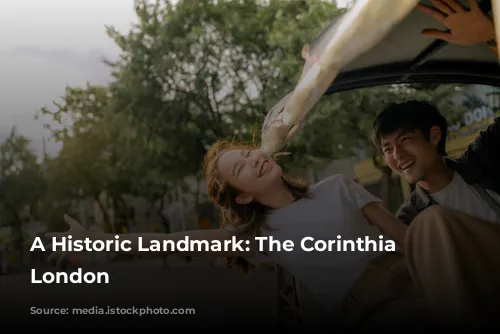The Corinthia Hotel London, a prominent fixture on the London landscape, boasts a fascinating past that weaves together grand hospitality, government service, and cinematic glamour. Nestled at the intersection of Northumberland Avenue and Whitehall Place, its strategic location has made it a witness to history, standing proudly between Trafalgar Square and the Thames Embankment.
From Metropole to Corinthia
Born as the Metropole Hotel in 1885, its proximity to the Palace of Westminster and government offices in Whitehall made it a natural target for requisition during the World Wars. Following World War II, the Ministry of Defence took over the hotel, converting it into government offices until it was deemed surplus and sold in 2007. This marked the beginning of its revival as a hotel, adopting the name Corinthia, a name that evokes both elegance and enduring legacy.
A Gathering Place for Royalty and Luminaries
The Metropole Hotel, in its early days, was a magnet for the elite. It played host to the annual dinners of the Aero Club and the Alpine Club, attracting renowned figures from aviation and mountaineering. In 1896, it served as the starting point for the inaugural London to Brighton run, an early motoring race. The hotel’s allure extended to the royal family, as the Prince of Wales, later King Edward VII, graced the hotel with his presence, reserving a box in the ballroom and making the Royal Suite, with its Whitehall Place views, his preferred abode.

The Hotel’s Transformation: From Cabaret to Government Hub
After World War I, the Metropole Hotel re-emerged as a vibrant hub of entertainment. The “Midnight Follies”, a popular cabaret show, took center stage, showcasing the talents of young musicians, including Bert Firman, who, at the tender age of 16, became the youngest bandleader in the world. Other renowned musicians, such as Mantovani, graced the hotel’s stages during the inter-war years.
In 1936, the hotel became the backdrop for a historic sporting moment. The England Rugby Union team triumphed over the New Zealand All Blacks, thanks to the legendary performance of Prince Alexander Obolensky. The Metropole Hotel, where the team celebrated their victory, became a witness to a legendary try, etched in rugby folklore.
The hotel’s fate took an unexpected turn in mid-1936, when the government, needing office space, leased the entire hotel for a substantial sum. This marked a transition from a hotel to a government hub, with the Ministry of Labour and the Ministry of Transport initially occupying its rooms, followed by the Air Ministry and the Ministry of Defence.

The Metropole: A Secret Wartime Headquarters
As the shadows of World War II loomed, the government extended its lease, once again commandeering the building. It became a vital center of government operations, housing various departments. Notably, Room 424 became the birthplace of MI9, the secret intelligence agency responsible for espionage and sabotage, and its sub-division, the Special Operations Executive, a key player in the resistance movement. This historical significance added another layer to the hotel’s story, transforming it from a luxurious destination into a vital war effort hub.
Following the war, the Ministry of Defence purchased the hotel, turning it into an extension of its Whitehall complex. The Air Ministry became a major occupant, and later, the Defence Intelligence Staff made it their home. This continued the hotel’s association with the government, its grand halls now echoing with the whispers of national security.

A Modern Renaissance: The Corinthia Hotel Reborn
After standing empty for several years, the Metropole Building and its adjacent property, 10 Whitehall Place, were purchased in 2007. A consortium led by IHI plc of Malta, with investment from the Libyan Foreign Investment Company and Nakheel Hotels of Dubai, embarked on a project to transform the buildings into a hotel and residential complex. This ambitious venture, approved by the City of Westminster council, brought the building back to life, breathing new life into the historical structure.
In 2011, the building reopened as the Corinthia Hotel London, managed by Corinthia Hotels International. 10 Whitehall Place was converted into luxury residences, while the hotel’s amenities were enhanced with an Espa spa. The hotel, now a blend of contemporary comfort and historical charm, has been attracting guests from around the world, seeking a luxurious experience steeped in history.

A Cinematic Icon: The Corinthia Hotel’s Silver Screen Glamour
The Corinthia Hotel’s allure extends beyond its luxurious accommodations and historic past; it has also captured the attention of filmmakers. In a nod to its past, the official announcement of the James Bond film “Skyfall” was made at a press conference held at the hotel in 2011. The hotel’s elegant facade and its connection to the world of espionage, a legacy of its wartime role as the home of MI9, made it an ideal setting for the unveiling of this iconic franchise’s latest installment.
In 2018, the hotel became the backdrop for “Red Sparrow”, a thrilling spy drama. Scenes were filmed both inside and outside the hotel, showcasing its opulent interiors and its prominent location. The film’s press junket and photocall also took place at the hotel, further cementing its place in the world of cinema.

A Modern Hub of Artistic Expression: The Artist in Residence Program
The Corinthia Hotel’s commitment to the arts is evident in its Artist in Residence program, which began in 2011. This program provides a platform for emerging and established artists, inviting them to showcase their work in the hotel’s unique setting. The program has featured writers, theatre companies, and filmmakers, with the chosen artist often selected through a national competition. The hotel’s historic spaces have become a canvas for artistic expression, showcasing a range of creative talents.
The Corinthia Hotel London stands as a testament to the enduring allure of history, luxury, and artistic expression. From its beginnings as a grand hotel to its wartime service as a center of intelligence and its current incarnation as a luxurious destination, the hotel’s journey reflects the vibrant tapestry of London’s past and present.







